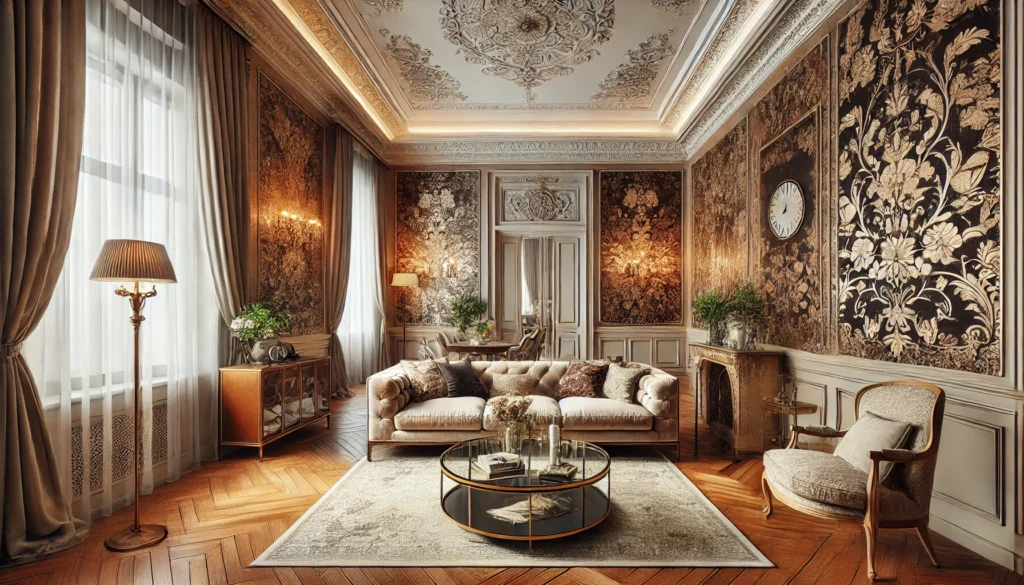Your cart is currently empty!
“Historical Wallpaper Styles: Timeless Designs That Inspire Modern Interiors”

Introduction:
Historical Wallpaper Styles isn’t just a decorative element; it’s a storyteller, weaving together centuries of design trends, cultural influences, and technological innovations. From the ornate patterns of the Victorian era to the sleek lines of mid-century modern design, historical wallpaper styles continue to inspire contemporary interiors. In this blog, we’ll take a journey through time, exploring key wallpaper styles and offering tips on how to seamlessly incorporate them into your modern spaces.
1. Renaissance and Baroque Wallpapers
Era: 16th–17th Century
Characteristics:
Imagine walking into a room adorned with elaborate damask patterns and floral motifs, often highlighted with shimmering gold and metallic accents.
Modern Use:
These wallpapers are perfect for creating a luxurious, vintage-inspired atmosphere in dining rooms or formal spaces.
Pro Tip: To truly capture the essence of this era, pair the wallpaper with rich fabrics and antique furniture for an authentic touch.
2. Victorian Wallpapers
Era: 19th Century
Characteristics:
Victorian wallpapers are known for their intricate, densely packed patterns, often featuring botanical themes like flowers, leaves, and vines, all in dark, dramatic color palettes.
Modern Use:
Consider using these wallpapers as an accent wall to infuse a bit of old-world charm without overwhelming your space.
Pro Tip: Balance the richness of Victorian designs with modern furniture to create a fresh twist on classic elegance.
3. Art Nouveau Wallpapers
Era: Late 19th–Early 20th Century
Characteristics:
With flowing, organic lines and stylized natural forms, Art Nouveau wallpapers often showcase floral and plant motifs in soft, muted colors.
Modern Use:
These wallpapers are ideal for bedrooms or living rooms that aim for a calming, artistic vibe.
Pro Tip: Enhance the Art Nouveau feel by matching the wallpaper with curved furniture and pastel accents.
4. Art Deco Wallpapers
Era: 1920s–1930s
Characteristics:
Art Deco is all about bold geometric patterns and symmetrical designs, often featuring luxurious materials and metallic tones like gold and silver.
Modern Use:
These wallpapers shine as accent walls in living rooms, entryways, or home offices.
Pro Tip: Pair them with sleek, modern furniture and metallic decor elements for a glamorous, sophisticated look.
5. Mid-Century Modern Wallpapers
Era: 1940s–1960s
Characteristics:
Characterized by simple, clean designs with abstract and geometric patterns, Mid-Century Modern wallpapers often feature earthy tones with pops of bright colors.
Modern Use:
They work beautifully in kitchens, dining rooms, or as a feature wall in any space.
Pro Tip: Combine these wallpapers with retro-inspired furniture for a cohesive and nostalgic look.
6. 1970s Retro Wallpapers
Era: 1970s
Characteristics:
Think bright, bold colors and psychedelic patterns, often featuring florals, paisleys, and geometric designs.
Modern Use:
These wallpapers are perfect for playful or creative spaces like children’s rooms or studios.
Pro Tip: Use them sparingly to avoid overwhelming the aesthetic.
7. Modern Revival of Historical Styles
Description:
Today’s wallpaper manufacturers are breathing new life into historical designs, reinterpreting them with updated colors, textures, and materials.
Examples:
Imagine Art Deco patterns crafted from eco-friendly materials or Victorian florals in softer, modern color palettes.
Pro Tip: Combine these historical styles with modern furniture and decor to achieve a beautifully balanced look.
8. Tips for Incorporating Historical Wallpapers Today
- Use as a Statement Piece: Feature historical wallpaper on one wall to create a stunning focal point.
- Balance with Minimalism: Pair intricate patterns with simple, modern furnishings to keep the space feeling fresh.
- Mix and Match: Don’t be afraid to combine different eras for a unique, eclectic style.
- Choose the Right Space: Opt for formal designs in dining rooms and playful patterns in children’s rooms.
Conclusion:
Historical wallpaper styles bring a timeless elegance and charm that can elevate modern interiors, adding depth and character. Whether you’re captivated by the boldness of Art Deco or the romance of Victorian designs, there’s a wallpaper style that can perfectly complement your taste and space.
Call to Action:
What’s your favorite historical wallpaper style? We’d love to hear your thoughts in the comments! And don’t forget to subscribe to our blog for more interior design inspiration!
Leave a Reply